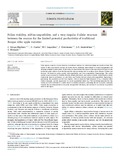Mostrar el registro sencillo del ítem
Pollen viability, self-incompatibility, and a very singular S-allele structure between the reasons for the limited potential productivity of traditional Basque cider apple varieties
| dc.creator | Crespo Martínez, Sara | es_ES |
| dc.creator | Oneka Mugica, Oihane | es_ES |
| dc.creator | Laquidain Imirizaldu, María Jesús | es_ES |
| dc.creator | Urrestarazu Vidart, Jorge | es_ES |
| dc.creator | Santesteban García, Gonzaga | es_ES |
| dc.creator | Miranda Jiménez, Carlos | es_ES |
| dc.date.accessioned | 2023-09-08T14:52:03Z | |
| dc.date.available | 2023-09-08T14:52:03Z | |
| dc.date.issued | 2023 | |
| dc.identifier.citation | Crespo-Martínez, S., Oneka, O., Laquidáin, M. J., Urrestarazu, J., Santesteban, L. G., Miranda, C. (2023) Pollen viability, self-incompatibility, and a very singular S-allele structure between the reasons for the limited potential productivity of traditional Basque cider apple varieties. Scientia Horticulturae, 322(1), 1-10. https://doi.org/10.1016/j.scienta.2023.112395. | en |
| dc.identifier.issn | 0304-4238 | |
| dc.identifier.uri | https://hdl.handle.net/2454/46289 | |
| dc.description.abstract | Cider regions conserve a broad diversity of traditional cultivars for which knowledge has hardly evolved. Key aspects of their reproductive biology are barely known, hindering improvement in orchard management and resulting in highly variable yields. In this study, we characterized key aspects of the reproductive biology of some traditional apple cultivars from the Basque-style cider-producing area in northern Spain (Basque Country and Navarre). We tested for pollen quality, self-compatibility, and cross-compatibility (S-genotyping). The pollen quality was good except for Urtebete, Errezila, Reineta Encarnada, and triploid varieties. Self-pollination results confirm the need for pollinators, as only Moko and Txalaka showed certain self-compatibility. Regarding Sgenotyping, the population proved very singular, with an atypically high frequency of S26, a frequent allele within crabapples, and the appearance of a novel unpublished allele (S60). The knowledge generated for this variety pool will contribute to a better choice of suitable pollinators, preventing the use of popular crabapple varieties that are demonstrated to be partly incompatible with them, and will lead to an increase in potential yields in the region. | en |
| dc.description.sponsorship | This work was supported the Diputación Foral de Gipuzkoa, Departamento de obras hidráulicas y urbanismo (contract number 2019907195) “Determinación de las causas de la baja productividad de las plantaciones de manzano en Gipuzkoa / Gipuzkoako sagarrondo landaketen produktibitate baxuaren arrazoiak zehaztea” and the projects APPLECUT (PID2019-108081RR-C21) and APPLEDIV (PID2022-141847OR-C32) financed by the Ministry of Science and Innovation (Spain). Open access funding provided by Universidad Pública de Navarra | en |
| dc.format.mimetype | application/pdf | en |
| dc.format.mimetype | application/vnd.ms-excel | en |
| dc.language.iso | eng | en |
| dc.publisher | Elsevier | en |
| dc.relation.ispartof | Scientia Horticulturae, 322 (2023) 112395 | en |
| dc.rights | © 2023 The Authors. This is an open access article under the CC BY-NC-ND license. | en |
| dc.rights.uri | http://creativecommons.org/licenses/by-nc-nd/4.0/ | |
| dc.subject | Malus x domestica | en |
| dc.subject | Reproductive biology | en |
| dc.subject | Traditional cultivars | en |
| dc.title | Pollen viability, self-incompatibility, and a very singular S-allele structure between the reasons for the limited potential productivity of traditional Basque cider apple varieties | en |
| dc.type | Artículo / Artikulua | es |
| dc.type | info:eu-repo/semantics/article | en |
| dc.date.updated | 2023-09-08T14:21:57Z | |
| dc.contributor.department | Agronomía, Biotecnología y Alimentación | es_ES |
| dc.contributor.department | Agronomia, Bioteknologia eta Elikadura | eu |
| dc.contributor.department | Institute for Multidisciplinary Research in Applied Biology - IMAB | en |
| dc.rights.accessRights | Acceso abierto / Sarbide irekia | es |
| dc.rights.accessRights | info:eu-repo/semantics/openAccess | en |
| dc.identifier.doi | 10.1016/j.scienta.2023.112395 | |
| dc.relation.projectID | info:eu-repo/grantAgreement/AEI/Plan Estatal de Investigación Científica y Técnica y de Innovación 2017-2020/PID2019-108081RR-C21/ES/ | en |
| dc.relation.projectID | info:eu-repo/grantAgreement/AEI//PID2022-141847OR-C32 | en |
| dc.relation.publisherversion | https://doi.org/10.1016/j.scienta.2023.112395 | |
| dc.type.version | Versión publicada / Argitaratu den bertsioa | es |
| dc.type.version | info:eu-repo/semantics/publishedVersion | en |
| dc.contributor.funder | Universidad Pública de Navarra / Nafarroako Unibertsitate Publikoa | es_ES |



